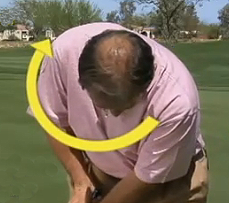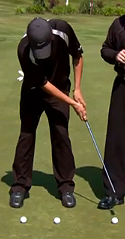by Dr Paul Hurrion
Quintic Ball Roll is the brainchild of internationally recognised Sports Biomechanist Dr Paul Hurrion (perhaps best known as Padraig Harrington's trusted putting advisor and biomechanics analyst over the past six years). He works with many other Tour golfers including Rory McIlroy, Oliver Wilson, Paul McGinley, Robert-Jan Derksen (featured here) and Lee Westwood. He has also applied his top level skills, knowledge and experience into the design of his own range of putters with GEL Golf |
Quintic Technology – it's Trackman for putting
I have spent the last five years developing what is today known as Quintic Ball Roll Software and now use it regularly in all of my analysis when working with my clients on the putting green. Quintic Ball Roll v2.4 software is capable of analysing up to 240 frames per second, automatically recognising markers on the golf ball, and instantly producing fully digitised analysis of each putt.
The software tracks the ball for the first 30cm of its journey on a given length of putt. It then instantly and clearly shows the ball speed, side spin (cut or hook), angular rotation (degrees & RPM), vertical bounce, launch angle and point at which true roll occurs.

Crucially – and this is the most significant advance on Quintic’s already pioneering analysis tools – all of the above are reflected graphically and numerically in a summary sheet in a way that was formerly only available for full swing analysis software for irons and woods. The average, range and standard deviation of the putts are automatically updated after each putt and can be saved into a session folder. It is then possible to compare session results, for example, with different types of putter, before and after changes to the loft / lie / length of a putter and before or after a putting lesson.With the help of Robert-Jan Derksen, let me show you how it works.
The clue is in the detail – key figures reveal the true quality of impact
The screen grab that you see here (above) was taken from a recent session with Robert-Jan Derksen on the putting green at Celtic Manor. Following a simple calibration procedure (see the T-bar image) we start the session with a 12-foot straight putt. [The software can be used on all types of putts – long, short, uphill, left to right, right to left... Is there a particular length of putt your are struggling with?]
 I have been working with Robert for nearly two years, and we are finally starting to see the results. In the following example, the read out on the computer reveals just what I am looking for in terms of how the golf ball reacts after contact with the putter (See Good Putt.bmp). This is as a result of a square set-up, good posture, a centre strike, no deviation in the path of the putter through the hitting area and a square putter-face at impact.
I have been working with Robert for nearly two years, and we are finally starting to see the results. In the following example, the read out on the computer reveals just what I am looking for in terms of how the golf ball reacts after contact with the putter (See Good Putt.bmp). This is as a result of a square set-up, good posture, a centre strike, no deviation in the path of the putter through the hitting area and a square putter-face at impact.
In other words, we are looking for consistency in all areas that determine the initial roll of the ball on its way to the target.
Ball speed? You can’t hope to read a green if you can’t control the pace of the golf ball. Similarly, you will never consistently roll putts on your chosen line if you impart side spin, or strike the ball with an erratic launch angle.
In recent months Robert has struggled on his initial pace control through having too much loft at impact, causing the ball to ‘jump’ and backspin after impact. But this analysis tells me he is getting much better; there is zero side spin (-2.27rpm is negligible), and the ball started its forward rotation immediately after impact. The launch angle is less than 2 degrees, which is perfect.
Other information provided by the Quintic analysis:
• Initial ball speed – 9.15 feet/sec which results in the golf ball travelling approximately 20 feet on a flat green with a Stimpmeter reading of 11.
• The point of ‘True Roll’ occurs after just 20 inches (<10%of the travel distance).
• The Launch Angle was 1.68 degrees and the result was a smooth forward roll for the first 12 inches. In my studio, the robot achieves the quickest point of True Roll with a launch angle of 1.00 degrees.When working with players, this is the launch angle I am trying to achieve, I certainly don’t want a negative launch angle as the ball will pop up as a result of being driven into the ground!
• The ball has rotated 191º after the first 12 inches of its path, with 731rpmof forward rotation at this point.
Understanding the true nature of the fault accelerates the fix...
For the purposes of revealing the sort of data we might expect on a poorly struck putt, I asked Robert to hit a ball with cut-spin.
And this is where the software really does come into its own in terms of teaching, because you would never pick up on these faults with the naked eye. This data shows the negative effect of too much cut spin on the performance of the golf ball. The cut spin number (+36.85) turns RED to highlight more than an acceptable amount of cut spin imparted on the ball at impact. This cut spin caused the ball to skid for 2 inches before starting forward rotation and it bounced significantly for the first 12 inches of its journey even though it had a good Launch Angle of 1.07 degrees.
As a result, it has taken considerably longer to reach the point of ‘True Roll’. Common causes of too much cut spin?:
• An outside-to-inside putting stroke
• An open putter face at impact
• Striking the putt out of the ‘heel’
• Putter with lie angle too low (heel high)

I advocate the left below- right grip in putting for the symmetry it gives you – i.e. levels the shoulders and facilitates a true pendulum motion.
Natural release of the putter should result in a through swing that mirrors the backswing – a natural arc either side of the ball |
While cut-spin is a no-no, scientific testing using a fixed robot and a high-speed camera (1000fps) proves that up to 10 rpm of hook or cut spin imparted to the ball is acceptable as having negligible effect. [As soon as side spin increase above 10 rpm, the side spin can cause the ball to spin, bounce and stray from the intended line. Just picture a spin bowler in cricket when the ball bounces!] The increased amount of hook spin, even with a good launch angle has produced a good ‘True Roll’ value (<15%). The act of hooking the golf ball can actually produce a quicker true roll but still is the cause of deflection which is exaggerated on a right to left breaking putt (right-handed golfer), especially with a high launch angle. Common causes of too much hook spin?:
• inside to outside putting stroke
• putter face closed at impact
• striking the putt out of the ‘toe’
• putter with lie angle too high (toe high)
Why correct putter fitting is ultimately the only route to consistency
By measuring how the ball reacts as it comes of the clubface you can determine the correct loft, lie and length of the ideal putter – it’s the ultimate putter fit! The ideal launch angle (for most greens) is between 0.75 and 1.25 degrees. Slower greens (or greens that have a lot of grain) require up to 2 degrees of launch angle to get the ball up out of its resting position and riding on top of the grass. If the launch angle is too high the ball will, literally, launch up into the air, high above the grass and bounce as it’s moving towards the hole. While the ball is bouncing, it has a greater chance of being deflected off line by either the side (hook or cut) spin or imperfections in the green.
Common causes of high launch angle?
• too much dynamic loft at impact
• breaking the wrist (‘flipping’) just before impact
• having the ball too far forward in the stance
• putter with too much static loft
While the ball is skidding or sliding over the grass (with no forward rotation) it is much easier for it to be deflected off line by imperfections in the green – e.g. spike marks, pitch marks, footprints, grain. This deflection will cause a putt that started on the intended line to miss the hole and /or lose speed too quickly as a result of sliding into a slope or grain. On many occasions the golf ball rotates backwards for the first few inches. Obviously the harder a putt is struck, the more the tendency of the ball to skid.
Causes of unacceptable skid?
• too much static loft on the putter
• ineffective putter face technology
• too much dynamic loft at impact
• breaking the wrist (‘flipping’) just before impact
• having the ball too far forward in the stance
Common causes of low launch angle?
• not enough dynamic loft at impact
• hitting down on the ball with the putting stroke
• having the ball too far back in the stance
• the putter not having enough static loft

1. Perfect fit: the putter-head sits flush, while the angle of the shaft and left forearm match up.
2. NO! Putter is too upright, causing the heel to come up off the ground (causes pushed putts)
3. NO! The toe is in the air, putter sits too flat; typical symptoms include missing left, pulled putts |
The majority of putters come as standard with 3 or 4 degrees of static loft. This may or may not be right for you. Analysing your personal putting stroke, your own hand position at address and impact and your preferred ball position will allow for the correct calculation of loft and lie for your putter (that’s if you can repeat it consistently?!). Ideally, especially for PGA Tournament Professionals, it would be advisable to select putters with different lofts depending on the type of green (grass type/depth /speed) you are playing to optimise the correct launch angle and therefore roll characteristics of the golf ball.
For more information, visit www.quinticballroll.com






 I have been working with Robert for nearly two years, and we are finally starting to see the results. In the following example, the read out on the computer reveals just what I am looking for in terms of how the golf ball reacts after contact with the putter (See Good Putt.bmp). This is as a result of a square set-up, good posture, a centre strike, no deviation in the path of the putter through the hitting area and a square putter-face at impact.
I have been working with Robert for nearly two years, and we are finally starting to see the results. In the following example, the read out on the computer reveals just what I am looking for in terms of how the golf ball reacts after contact with the putter (See Good Putt.bmp). This is as a result of a square set-up, good posture, a centre strike, no deviation in the path of the putter through the hitting area and a square putter-face at impact.










